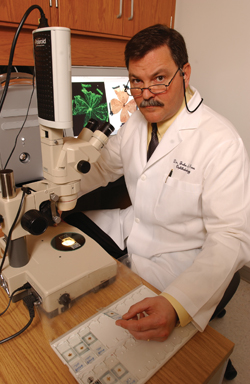
John Penn, Ph.D., was named to receive a Senior Scientific Investigator Award from Research to Prevent Blindness Inc.
photo by Anne Rayner
Center nurtures commercial viability of research
Vanderbilt is inviting faculty members who have ideas for commercial technology to take advantage of the University's affiliated biomedical business incubator, the CET Life Sciences Center, located at 111 10th Ave. South.
CET stands for Cumberland Emerging Technologies. It's a joint venture of Cumberland Pharmaceuticals Inc., Tennessee Technology Development Corp. and Vanderbilt University. The company was formed three years ago to aid early commercial development of biomedical technology conceived by investigators at Vanderbilt and other research centers in the region. CET leases lab space and provides access to experts who can guide investigators as they begin to find their way toward commercial viability.
As enterprising academic researchers take their ideas off campus and in the direction of commercial application, other funding sources pick up where the National Institutes of Health leave off. The primary funding sources targeted by CET on behalf of investigators include two federal grant programs coordinated by the U.S. Small Business Administration: SBIR (Small Business Innovation Research) and STTR (Small Business Technology Transfer Research). The latter program in particular fosters partnerships between universities and for-profit companies.
The CET incubator is about to expand to 6,800 square feet, with potential to grow to 20,000 square feet.
“With this upcoming expansion of our Life Sciences Center, we look forward to working with more of the many talented investigators from the Vanderbilt faculty,” said CET Chief Executive Officer A.J. Kazimi, who is also CEO of Cumberland Pharmaceuticals Inc. “CET can help secure early-stage funding and coordinate expertise from its affiliated organizations to provide program management and to help with marketing and industrial development,” Kazimi said.
“CET gives us an experienced group of people to work with to help our investigators at the earliest stage in translating discoveries into licensable products or small start-up companies,” said Jeffrey R. Balser, M.D., Ph.D., associate vice chancellor for Research.
Balser contrasted CET, which is able to offer lab space in increments as small as 200 square feet, with a larger Vanderbilt business incubator that will open later this year at Cool Springs in Williamson County, where the typical tenant company will occupy at least 4,000 square feet and will have already secured venture capital.
“While many 'incubators' are focused on start-ups that are more advanced in the development of a product, CET gives our investigators an option at the more embryonic stage of development,” Balser said. While there has been increased patenting activity among Vanderbilt faculty, “We think we've only seen the tip of the iceberg and that resources like CET will help expand this activity tremendously.”
The commercialization of ideas conceived by faculty members is increasingly viewed as a viable, expanding source of university funding. VUMC faculty who collaborate with CET keep any intellectual property ownership granted to them under their terms of employment at Vanderbilt.
“CET represents a demonstrated model of success for the private sector, public sector, and academic community to collaborate effectively in bringing new and promising technologies to the marketplace,” said Christopher D. McKinney, director of Technology Transfer and Enterprise Development at Vanderbilt.
For more information contact CET at 255-0068.













